

Before you move on, save all your data, because you will be restarting your PC soon. After a minute, you'll see an Imaging complete notification, which means your device is ready to use MemTest86. The program will ask you if you're really sure, since this part formats your storage device. Step 4: At the top of the window, select the storage device you want to use for MemTest86, then find the Write button at the bottom and select it. Again, your storage device will be formatted, so make sure nothing important is on it. Step 3: Plug in your USB storage device and run imageUSB.exe. zip file and copy/paste its contents into a new folder. Step 1: Download the free version of MemTest86 on PassMark's website. All you need to use MemTest86 is a USB storage device, which you will have to format, so make sure there's nothing important on the device Much like Windows Memory Diagnostic, it runs a test outside of Windows itself, so you'll be unable to use your PC while the test is going. If your PC passed the Windows Memory Diagnostic but you still suspect you have a RAM issue, then you'll want to try MemTest86, a much more comprehensive test by PassMark. A fail means the RAM is unstable, and you should replace your modules. Once you log in, you'll get a notification that will inform you whether your RAM passed the test. Step 4: Once the test finishes, your PC will reboot back into Windows. This takes about 15-30 minutes to complete.

Step 3: When your PC reboots, you'll be greeted with a blue-looking screen that tells you that your RAM is being tested. What is RAM? Here’s everything you need to know These are the PC games pushing people to buy more RAM


 0 kommentar(er)
0 kommentar(er)
